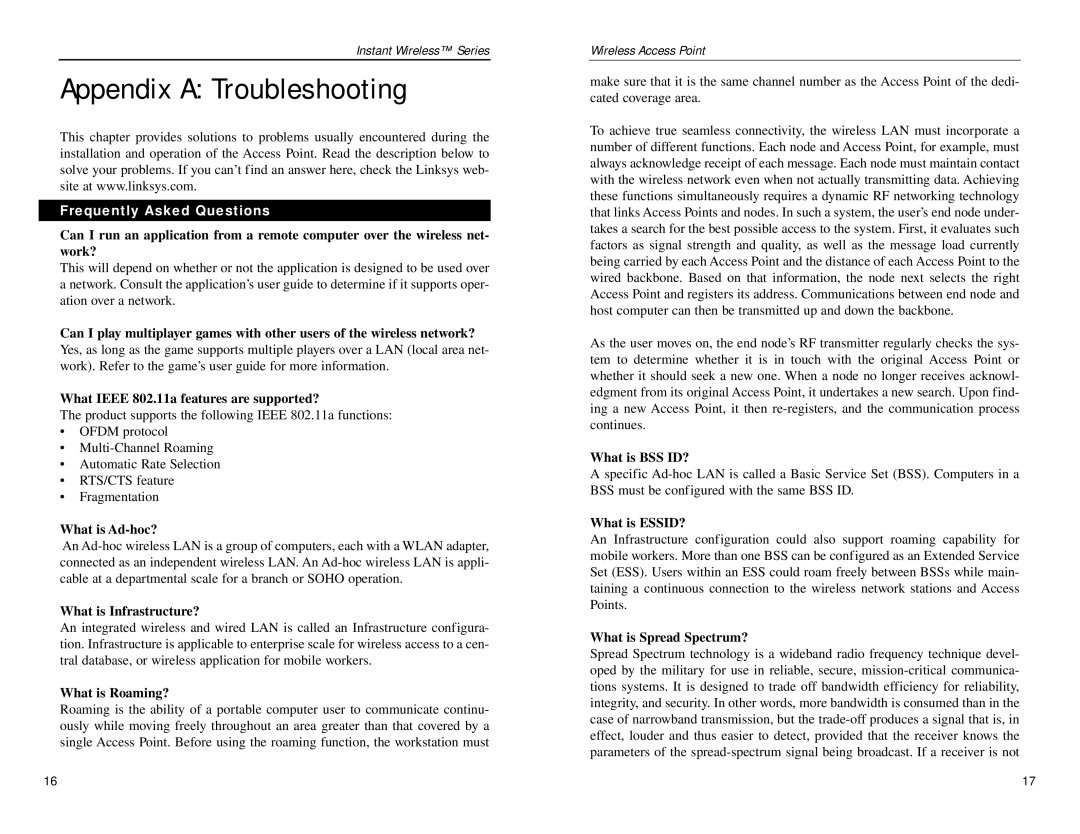
Instant Wireless™ Series
Appendix A: Troubleshooting
This chapter provides solutions to problems usually encountered during the installation and operation of the Access Point. Read the description below to solve your problems. If you can’t find an answer here, check the Linksys web- site at www.linksys.com.
Frequently Asked Questions
Can I run an application from a remote computer over the wireless net- work?
This will depend on whether or not the application is designed to be used over a network. Consult the application’s user guide to determine if it supports oper- ation over a network.
Can I play multiplayer games with other users of the wireless network?
Yes, as long as the game supports multiple players over a LAN (local area net- work). Refer to the game’s user guide for more information.
What IEEE 802.11a features are supported?
The product supports the following IEEE 802.11a functions:
•OFDM protocol
•
•Automatic Rate Selection
•RTS/CTS feature
•Fragmentation
What is Ad-hoc?
An
What is Infrastructure?
An integrated wireless and wired LAN is called an Infrastructure configura- tion. Infrastructure is applicable to enterprise scale for wireless access to a cen- tral database, or wireless application for mobile workers.
What is Roaming?
Roaming is the ability of a portable computer user to communicate continu- ously while moving freely throughout an area greater than that covered by a single Access Point. Before using the roaming function, the workstation must
Wireless Access Point
make sure that it is the same channel number as the Access Point of the dedi- cated coverage area.
To achieve true seamless connectivity, the wireless LAN must incorporate a number of different functions. Each node and Access Point, for example, must always acknowledge receipt of each message. Each node must maintain contact with the wireless network even when not actually transmitting data. Achieving these functions simultaneously requires a dynamic RF networking technology that links Access Points and nodes. In such a system, the user’s end node under- takes a search for the best possible access to the system. First, it evaluates such factors as signal strength and quality, as well as the message load currently being carried by each Access Point and the distance of each Access Point to the wired backbone. Based on that information, the node next selects the right Access Point and registers its address. Communications between end node and host computer can then be transmitted up and down the backbone.
As the user moves on, the end node’s RF transmitter regularly checks the sys- tem to determine whether it is in touch with the original Access Point or whether it should seek a new one. When a node no longer receives acknowl- edgment from its original Access Point, it undertakes a new search. Upon find- ing a new Access Point, it then
What is BSS ID?
A specific
What is ESSID?
An Infrastructure configuration could also support roaming capability for mobile workers. More than one BSS can be configured as an Extended Service Set (ESS). Users within an ESS could roam freely between BSSs while main- taining a continuous connection to the wireless network stations and Access Points.
What is Spread Spectrum?
Spread Spectrum technology is a wideband radio frequency technique devel- oped by the military for use in reliable, secure,
16 | 17 |
